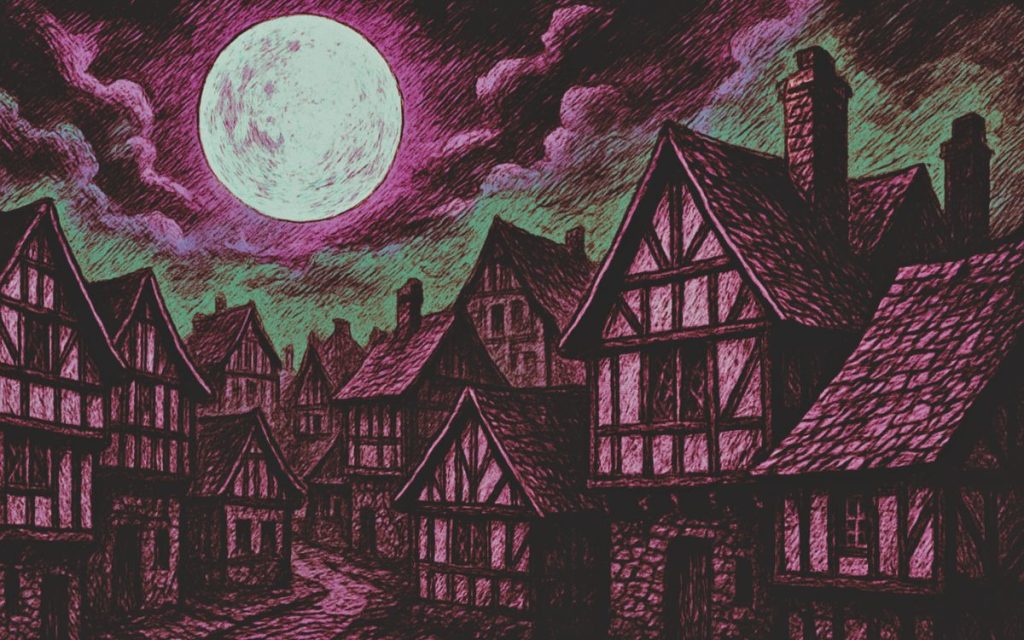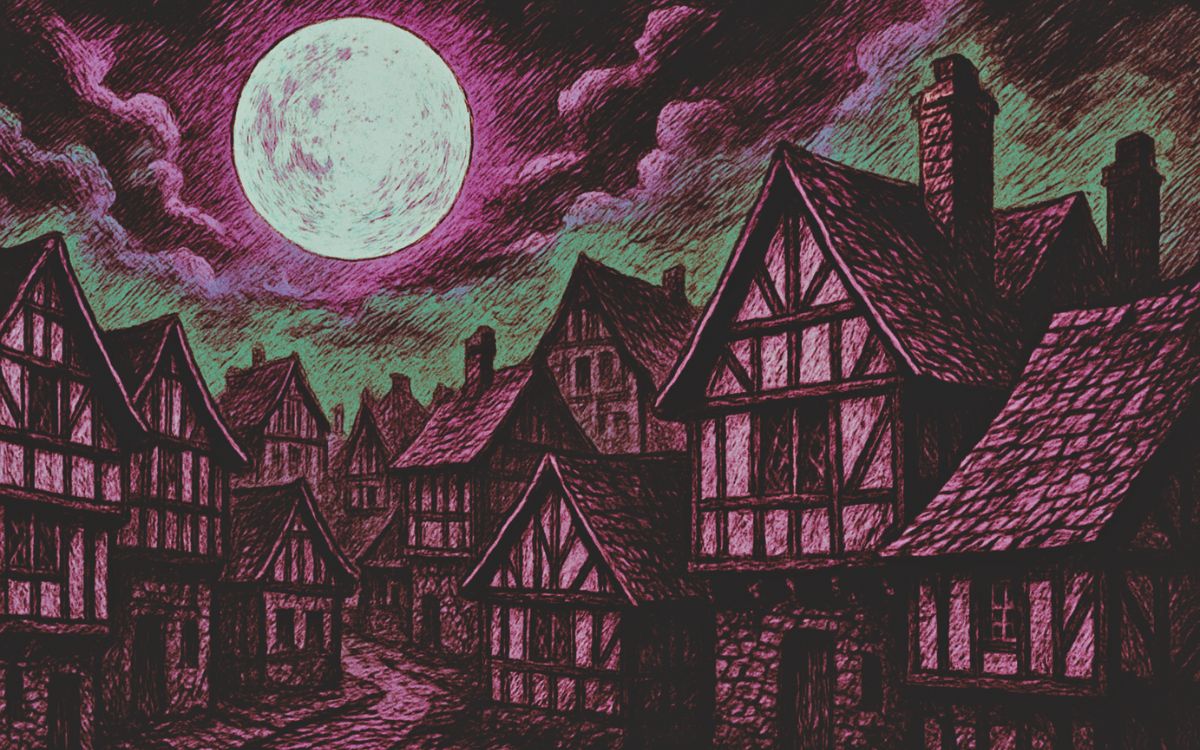EDDIE BRAZIL explores how mysterious night-time sounds fuel eerie folklore across Britain, from phantom dogs to the legendary Beast of Bucks
Have you ever woken in the small hours and been unable to get back to sleep?
We lie in bed, staring up at the shadowy ceiling, listening to the silence of the night. It is a stillness sometimes punctuated by sounds we normally dismiss during the day.
They’re sounds which the English ghost story writer M. R. James described as having the power of forming pictures in the mind—or of folklore tales to be told.
Sometimes, these sounds can be pleasant and feel beneficial, even comforting.
The nearby toll of a town hall clock chiming the hours makes us think of benign eyes watching out over the town, assuring us all is well.
There is also the late-night raucousness of happy partygoers making their noisy way home—sounds which, if we are alone, make us feel glad there are other people abroad at such an otherwise deserted and lonely hour.
Haunting echoes in the darkness
Yet there are also sounds which can be eerie and melancholy to the ear, making us think of the strangeness of the small hours.
The far-off drone of a prop plane engine fading in the moonlit sky can put us in mind of a phantom World War II bomber and its ghostly crew returning to their long-gone airfield.
The sound of the wind in the chimney, or a slow moaning around the house, can make us think there’s a host of spooks trying to enter.
The strange howl and lingering meow of a cat can convince us a hag witch or banshee has come to cart us away.
The decrepitation of wood as the house cools makes the creaks and cracks on the stairs sound like someone — or something — is ascending the steps to our room.
The distant bark and its folklore
Perhaps the most iconic of night-time sounds is one most of us have probably heard at one time or another: the distant bark of a lonely dog.
The word “distant” is important here.
If the sound of the barking dog was coming from the house next door, its insistent yelping would soon get on our nerves and we would want it to stop.
The sound coming from far off only adds to the melancholy of the night… as if the bark were coming from another time or place — or even the past.
It is a beautiful eeriness, similar to the romantic cry of a wolf calling across the moonlit prairie.
It is also a sound which asks questions.
Why is the dog barking? Is it loose in the streets? Is it lost? Has it escaped from somewhere?

Dogs of doom and ghostly hounds
Indeed, is it a real dog—or is it a snarling hound from hell roaming alone, searching for a late-night traveller who is unaware he is to be the dog’s next prey?
It is definitely a sound capable of forming pictures in the mind and creating folk tales—if our imaginations allow it to.
The folklore of the sounds of the night is a curious sideline off the main myth and legend pantheon, inasmuch as these are tales confined to small areas of the country, and in many instances to individual families.
One might hear vaguely similar stories all over Britain, but they are, in their content, unique to small groups—handed down rather than spread across wider regions.
Indeed, some northern folks may never have heard of the myths and legends of their southern neighbours.
There is a tradition in southern Buckinghamshire, near to London, which warns that to wake in the small hours on three consecutive nights and hear the distant bark of a dog is a bad omen — and that ill fortune will soon follow.
An omen in the fields of Aylesbury
The origins of this piece of folklore are unclear.
It is possible that it is an amalgamation of many stories of phantom dogs—particularly Black Shuck, the devil hound of Suffolk—which writer Arthur Conan Doyle drew upon as inspiration for his classic novel The Hound of the Baskervilles.
One such devil dog tale from Aylesbury makes us wonder if the poor unfortunate victim heard the midnight barking three times.
For several nights, a man walking to milk his cows in the early hours of the morning encountered a large black dog which blocked his path.
He finally grew tired of having to walk around the hound and, while walking with a friend, struck the creature.
The dog vanished — but the man fell down paralysed, never to be able to move or speak again.
The Beast of Bucks emerges
Another phantom hound said to haunt not only the Buckinghamshire night but also the seemingly benign daylight hours is the ominously titled Beast of Bucks.
During the 1980s and 90s, Penn Woods, near Amersham, made the headlines in the local press as being the lair of a murderous hound from hell, which lay in wait for anyone foolish enough to venture deep into the trees.
Of course, such stories to the rationally minded only bring wry smiles and ridiculing laughter.
Where is the evidence, they say? Has anybody seen it? Has anybody ever heard it?
Eventually, scanty evidence emerges.
Large black shapes seen running through the trees at dusk, and ominous shrieks and growls deep within the wood at night.
From legend to terrifying reality
The story is eventually dismissed as a tale to scare children and filed under the heading of village folklore.
However, something then occurred which took the beast out of the folklore file and thrust it into the uncomfortable realms of reality.
Evidence had been found.
Remains of partially eaten animals were discovered within a section of the woods where the black shapes had been seen.
Scars and marks were found on trees which seemed to have been made by a creature with talons and teeth.
Yet there was a piercing piece of evidence which seemed to confirm the stories.
In pure Hound of the Baskervilles style, investigators discovered prints made in the woodland soil.
They were the footprints of a gigantic four-legged creature.
The fear takes root
So, just as quickly as it was filed under folklore, the Beast of Bucks loomed once more—not as something to frighten children, but as a real, flesh-and-blood threat to anyone walking alone in the woods.
People became genuinely alarmed that they were dealing with a big wild cat, which had the ability not only to roam, but to kill.
The Government’s Dangerous Animals Act of 1976 required private owners of exotic animals—including pumas, panthers and lynxes—to register them.
Many ignored the ruling and released the cats into the wild.
One of them certainly made Penn Woods its lair.
Fortunately, despite the few sightings, the night-time noises and the tree bark markings, no one was harmed by the creature.
Folklore returns as fear fades
Since the 1980s and 90s, the evidence of the beast has been diminishing, suggesting that the cat has moved on.
There is plenty of woodland in Bucks to conceal such animals.
It has been over 40 years since the Beast of Bucks craze held everyone in excited fear.
People again walk their dogs in Penn Woods without trepidation.
However, as the years pass and memory of the real cat fades, a curious thing has happened.
Perhaps it is a human need for mystery and magic—a love of old stories to be told around the winter fireside.
The return of the hound from hell
It seems the mythical beast of Penn Woods has been reinstated, not just as an escaped wildcat, but as a ghostly hound from hell.
The nocturnal shrieks, barks and cries of woodland animals are now seen as evidence of a creature which will snare naughty children in the dead of night.
But it can’t harm them—as it’s only folklore.
The power of night sounds to create their own folklore is simple enough.
Our spirits are lowest in the small hours, especially if we are alone.
Even with a sleeping partner by our side, we still have to contend with our own fears and worries.
Listening to sounds far away—or indeed in the house—in a cold, dark, still bedroom charges up the irrational mind perfectly.
They are just sounds, but they could be something else—and they might be coming for me.
Night-time folklore is the flesh we put on the bones of those spooky night-time sounds.
In part two, Eddie explores the main culprit of night-time sounds and terrors, The Boogeyman.



